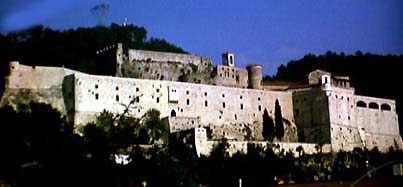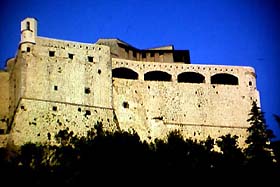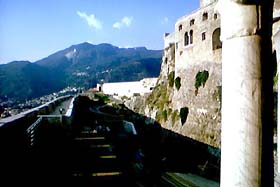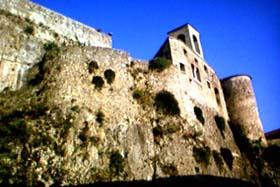Malaspina Castle - Massa
 |
 |
|
The mighty walled enclosure: the front toward the
city and the sea.
|
The southern rampart.
|
The mighty Castle dominates the center of the city of Massa. It can be reached following the Motorway A12 Genoa-Leghorn until the exit 'Massa'.
The castle of Massa crowns the top of a rocky hill and from its position dominates the wide underlying plain and great part of the Tyrrhenian coast line. Probably in the early Middle Age, due to the characteristic of the location, a fortified settlement rose up on the hill and documents mention a site called Massa since the year 882. Surely it was situated where today we can still admire the mighty castle.
 |
|
The inner ward viewed fron the palace.
|
The castle was the seat of the marquises of Massa and was always closely related to the coast and the sea, due to its strategic position for fighting against the pirates. From the year 1164 we have records of the castle, when Emperor Frederick I allotted part of this to Obizzo Malaspina. About a century later, in 1268, Massa was occupied by the troops of Corradino of Svevia, who devastated the whole territory. One year later the castle was leveled to the ground by the army of the nearby city of Lucca that didn't tolerate the willingness of the Massa inhabitants to please the Emperor's troops. Great part of the castle's history in the first centuries of the late Middle Age are obscure. When the marquises of Massa were ousted the Malaspina family took possession of the castle and conceded it to Castruccio Castracani, gentleman of Lucca, in the first years of 14th century. Until the first half of the 15th century Massa and its castle passed under the authority of the Lucchesi first, the Pisane then and of the Florentine for last. After this time Massa became fief of the marquises of the Malaspina family of Fosdinovo. Between 15th and 17th century the new owners underwent a series of drastic changes and the castle became their finest residence.
From the middle of 1600 the main function of the castle was military and at the end of the pre-unitary states it served until the the year 1946 as a prison. It was recently restored and reopened to the public.
We can consider the castle formed by three main architectural units: the surrounding bastionated walls full of gun ports and loopholes, the residential palace and the original medieval keep. These parts are preceded by a kind of barbican that with its walls enclose the outer ward, from here start the ramp of access, endowed of a drawbridge, at the real, and unique, castle entrance. All this area is under the fire of the bastions and the gun ports of the surmounting walls.
 |
|
The rock where rise the keep.
|
The curtain walls, delimiting the northwest front, create another large ward marked by a long wall walk, with two lines of gun ports pointing the sea and the town, and connect the northern rampart with the southern one. This part of the construction is dated between the 15th and the 16th century, built raising the preexisting medieval enclosure, which battlements can still be clearly seen in certain parts of the walls. A ditch carved in stone and other defenses, in great part lost, connect this courtyard with the ward of the residential palace, a renaissance building with an 'L' form and two richly decorated facades. In the north of this ward a drawbridge, now disappeared, connected the palace with the purely military core of the castle: the keep. This extreme defensive structure of the complex is autonomous and separated from the rest of the castle. It was built using an unusual technique: the existing rocks was smoothed creating vertical rock faces giving an incredible resistance at the construction. All the upper area of the castle housed the formerly medieval structure. The only original part are today a little cistern and the base of a tower, perhaps once the highest of the castle used as watchtower.
The castle is now opened to the public an visitable by a fee, but there are still some works of restoration going on.
| More Photos |
| View the castleMap |
| Back to Homepage |
| Back to Castles Index |